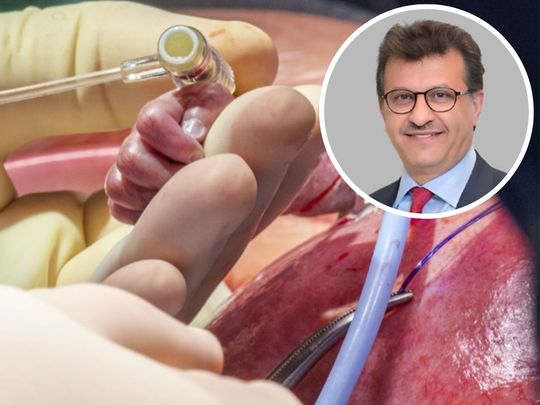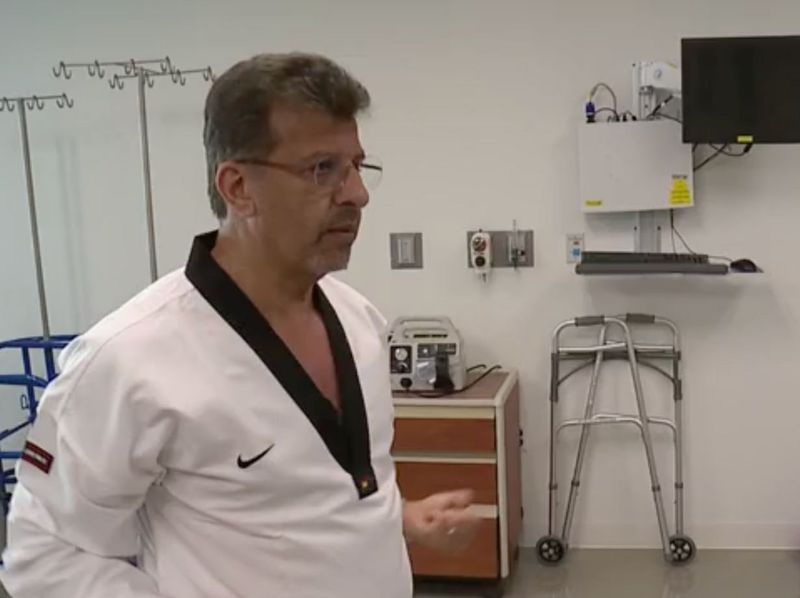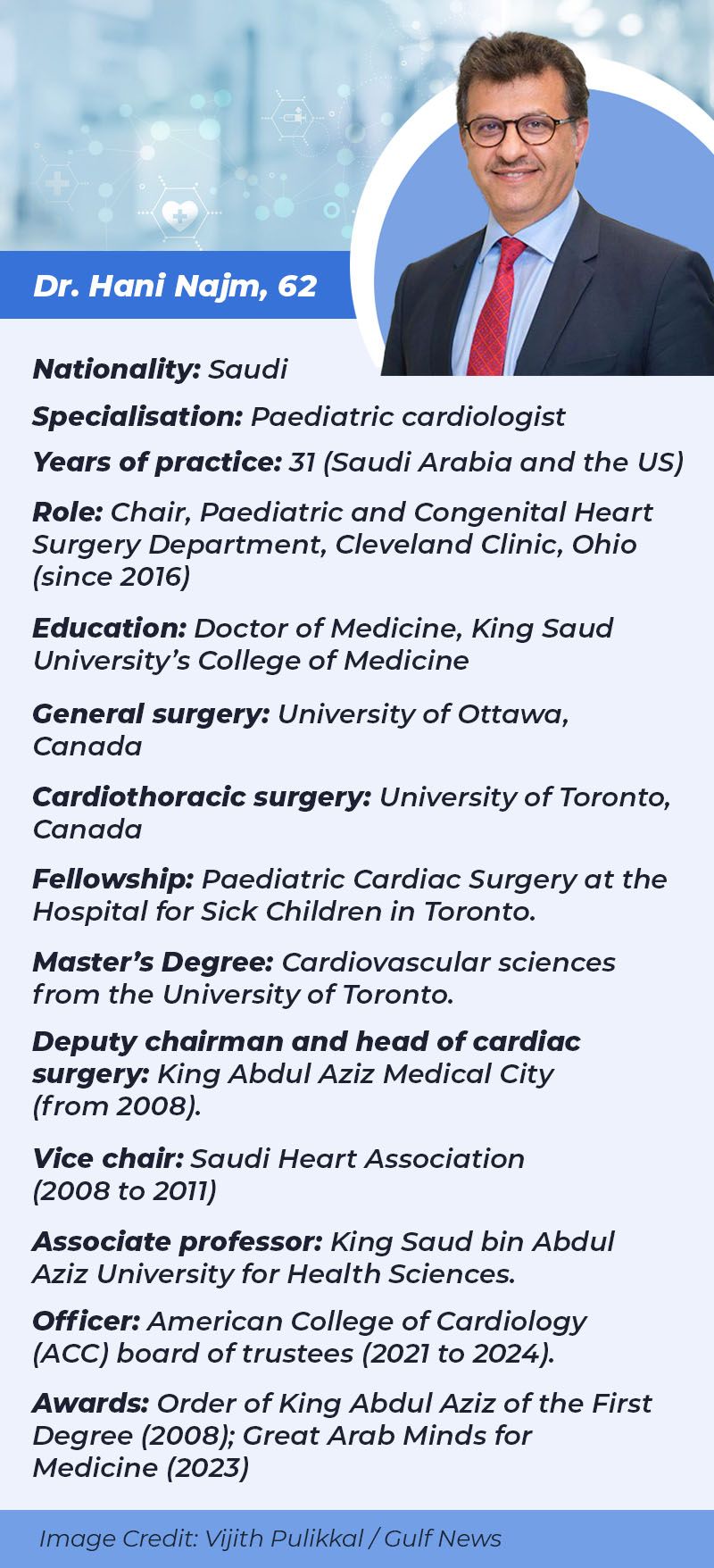
Highlights
- Dr Hani Najm, a Saudi doctor currently practicing in the US, has done more than 10k heart surgeries.
- He has developed a new technique that avoids future heart transplant in young patients.
Dubai: Dr. Hani Najm, a Saudi cardiologist practising in the US, does not run away from challenges. That includes the job of taking care of the “sickest of the sick”.
He has performed more than 10,000 complex heart surgeries – on foetuses, newborns, children, and adults, both in the Gulf and the US.
A 5th-Dan black belter in Taekwondo, having earned 3 gold medals as the Saudi Arabia Champion, he is also known for remarkable innovations in heart surgery to treat infants with congenital heart problems.
Dr Najm was the lead heart surgeon in a team that performed a rare and complex life-saving surgery to remove a heart tumour in a 26-week-old foetus.
A congenital heart defect is a problem with the structure of the heart that a child is born with. In this video explainer, he shares the new technique he developed to help children with a specific type of heart defect.
As a specialist, Dr. Najm – who chairs the Paediatric and Congenital Heart Surgery at Cleveland Clinic Children’s in Ohio (since 2016) – has the ability to offer the whole spectrum of heart surgery, including procedures that range from simple to the most complex.
His extensive experience allows him to take on challenging cases based on science, and to take calculated risks – a key component of his success.
'Ventricular switch'
An example is the “ventricular switch” – a novel surgical technique that Dr Najm, 62, developed a few years ago to repair one of the most complex congenital heart conditions in children. The technique is now common practice in the field.
A key highlight of his work is the development of a gradually self-expanding heart “valve” for children, sparing them the need for repeated surgery for valve replacement.
Another innovation: the “Najm double-shunt” technique. This novel approach involves “revascularising” an infant’s heart, to correct a problem with the blood flow and eliminate the need for a future heart transplant.
The road to transplant can be difficult, and the risk of coronary compromise is high while patients await the procedure. Moreover, heart transplantation doesn’t come without a cost, and timely access to transplant organs – particularly for infants – remains an issue.
The case, published in The Journal of Thoracic and Cardiovascular Surgery, involved a young patient born with a rare and complex condition known in medical terms as “pulmonary atresia with intact ventricular septum with right ventricle-dependent coronary circulation”.

Two-stage strategy
The two-stage strategy devised by Dr Najm literally meant two surgeries – six months apart.
The infant's condition resulted in a significantly undersized right side of her heart. Additionally, her heart's structure prevented oxygenated blood supply. Typically, she would require intubation while awaiting a heart transplant.
Thanks to this strategy involving innovative use of tubes to correct the blood flow, the infant’s condition has been stabilised. After two operations, she is now being monitored by Dr. Najm and his team ahead of a third and final surgery known as a Fontan operation.
Such procedures, outlined in such a high-impact journal, greatly enhances the survival of infants with congenital heart defects – thus avoiding the need for heart transplant.
Why is it a “game-changer”?
The technique could potentially help young patients in countries or places where access to complex heart transplant and post-op support are difficult.

2.5 m
estimated number of children with congenital heart defect born each year, or 6,853 daily out of 385k live births.Here’s why it's a “gamechanger”: the medical community has already recognised it as the “new standard of care”, helping other patients with the same condition avoid a transplant – or survive without mechanical assistance until a heart becomes available for transplant.
Dr. Najm explained: “The road to transplant can be difficult, and the risk of coronary compromise is high while patients await the procedure. Moreover, heart transplantation doesn’t come without a cost, and timely access to transplant organs – particularly for infants – remains an issue.
“In some parts of the world a heart transplant is not even a viable option for care. We hope this novel approach will not only prevent the need for transplant but may also improve longer-term outcomes in patients with right ventricle-dependent coronary circulation.”
The remarkably successful “Najm technique” has been celebrated by the international medical community.

It has far-reaching implications. While some congenital heart defects in children are simple and don't need treatment, others are more complex and may require several surgeries performed over a period of several years.
Heart surgery on a foetus
One remarkable procedure he and his team have done is an innovative surgery on a foetus.
Conceptualising novel procedures is made possible only by working with a team of vastly experienced surgeons operating in advanced cardiac centres.
“Innovation does not occur in isolation; it is the product of years of experience – working with cases, and thinking about them.
Dr. Najm says that Cleveland Clinic Children’s heart surgeons successfully create new procedures on an almost annual basis.
One that stands out involved removal of a large heart tumour from a baby still in its mother’s womb. Dr. Najm worked as part of a multidisciplinary team of experts.
1 in 77: US children had a heart condition, according to 2016 Centres for Disease Control and Prevention (CDC) data.
17.8 per 1,000 live births: Incidence of congenital heart disease globally, according to data published by the journal Frontiers in Medicine.
24.6 per 1,000: Incident of congenital heart defect, if patent ductus arteriosus (an extra blood vessel found in babies before birth and just after birth), in preterm infants was included.
6,853: Estimated number of children with congenital heart defect born daily, or 2.5 million babies per year.
During the life-saving operation, the male foetus’s arms and shoulders were gently lifted out of the mother’s uterus while his head remained inside, enabling access to the chest of the 26-week-old foetus so that Dr Najm could remove the tumour growing in his heart.
Following the surgery, both mother and foetus recovered well. The cardiac function immediately improved, and the foetus remained in the womb for the remainder of the pregnancy. Ten weeks later, the baby was born.
“Congenital heart defect” and “congenital heart disease” are often used interchangeably; “defect” is more accurate. Several categories of childhood heart problems are known: defects from faulty embryo development, misplaced structures, structures that don’t develop properly and heart rhythm disturbances.
These defects are usually – but not always – diagnosed early in life.
Congenital heart defects range in severity from simple problems, such as “holes” between chambers of the heart, to very severe malformations, such as the complete absence of one or more chambers or valves.
This innovation was driven by need. “Time was of the essence,” he explained. “From the imaging, I could see that the tumour was getting bigger, and fluid was collecting in the foetus’s pericardium and lungs, which is an indication of heart failure. Even though this had rarely been done before, the fact we have a life that may not survive otherwise always makes me want to do something,” says Dr. Najm.
He adds: “We are fortunate to be in a position to conceptualise and implement new procedures.” Physicians around the world are constantly collaborate, innovate as a team to improve patient outcome. “Our patients entrust their care to us.”
“I always wanted to contribute a lasting legacy to my specialty of cardiac surgery,” he said.

Nobel laureate?
Could Dr Najm could be the next Nobel Prize for Medicine laureate? We surely think so.
For his contributions to his field, Dr Najm has already been named the Great Arab Minds Award for Medicine – the Arab Nobel Prize – especially new procedures he developed that have saved countless young lives.
Asked what it means to receive what many are calling the first ‘Arab Nobel Prize for Medicine,’ Dr Najm said patients continue to be at the centre of his work.
“I have said many times that we work so hard for our patients’ improved outcomes, not ever for our own recognition. However, it is nice to be recognised for the pioneering work that I have done, and, more importantly, I hope to be the shoulders for my colleagues to stand on to improve the field of cardiac surgery.”

Some of Dr Najm's feats in medicine:
• He has performed more than 10,000 complex heart surgeries on newborns, children, and adults.
• Credited for devoping a novel way to revascularise an infant’s heart, thereby eliminating the need for a future heart transplant.
• He led a team that performed remarkable surgery involving the removal of a large heart tumour from a foetus still in its mother’s womb.
• Dr Najm has designed and developed a growth-compatible heart valve that can be implanted, adjusting as the child grows, avoiding the inherent risks of multiple surgical procedures.
BIO: Hani Najm, MD
- Education and Training: Medical degree from King Saud University, Riyadh, Saudi Arabia.
- Internship | residency: Rotating internship in Paediatrics, Obstetrics and Gynecology and a general surgery residency at King Khalid University
- Residency: General Surgery at Ottawa Civic Hospital, Canada,
- Residency: Cardiothoracic Surgery at The Toronto Hospital and Hospital for Sick Children (SickKids), Canada.
- Fellowship: Paediatric and Adult Cardiac Surgery at Hospital for Sick Children (SickKids) and Sunnybrook Health Sciences Centre, Toronto.
- Board-certified: Surgery and cardiothoracic surgery.
- Interests: Neonatal heart surgery, left ventricular outflow tract obstruction, arterial switch procedure, atrioventricular septal defect repair, adult congenital heart surgery, complex heart valve surgery, repeat valve and reconstructive heart surgery
- Specialty: Complex congenital and adult surgery that involves more than one valve, as well as repair of transposition of great arteries.
- Overall mortality rate: <1% in recent years, including many difficult cases.
- Technique: A unique repair technique for repair of a complete atrioventricular septal defect in more than 200 patients, with 15-year follow-up results described as “outstanding”.
- Practice: Chairperson, Paediatric and Congenital Heart Surgery and Executive Co-Director of the Pediatric and Adult Congenital Heart Center at Cleveland Clinic.
- 1999 to 2001: Consultant for Adult and Pediatric Cardiac Surgery at King Abdulaziz Cardiac Centre, Saudi Arabia
- 2001-2008: Served at King Abdulaziz Cardiac Centre in Saudi Arabia, including appointments as Deputy Chairman, and eventually Head of Cardiac Surgery
- 2016: Appointed to the Cleveland Clinic staff after serving as a consulting staff member in 2014.
- Master's Degree: Master’s of Science in Research Training and has been an educator and speaker at hundreds of professional meetings worldwide.
- Research, Publications and Speaking engagements: Dr. Najm serves in leadership roles for many professional heart and surgery societies throughout Europe, Asia and the Middle East.
- His dedication to research and the importance of multi-centre patient databases is exemplified in his work to establish the Congenital Heart Surgeons’ Society database and a database for patients treated in the congenital centre he established in Saudi Arabia.
- The centre was included in the multi-center “TOF Life” study, for which Dr. Najm was the Site Leader and Principal Investigator.








